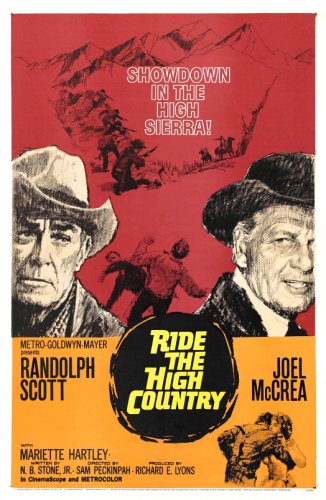

In the scene in which Joel McCrea enters the bank's bathroom, attached to the reservoir tank for the toilet is a modern shut-off valve.
There are a number of indications that this film is set no later than the late 1890s or early 1900s - for example, the date of Elsa's mother death on her tombstone and the open automobile (characteristic of early twentieth century models).
The heavily-worn dime that Judd (Joel McCrea) bets in the booth run by Westrum (Randolph Scott) in the opening scenes, however, is a "Mercury" (Winged Liberty) dime, first coined in 1916.
The dime shown, moreover, could not have become so worn without several more years in circulation.
The "snow" shown on the ground in a number of scenes in the mining camp is obviously foam.
This is clear from, for example, the scene when Billy Hammond (James Drury) throws his brother Jimmy (John Davis Chandler) out of the "honeymoon" tent onto his back.
The "snow" splatters like foam, not snow.
When Elsa is cleaning the barn, she has two shadows even though it's daylight and no lanterns in the barn are lit.
Joel McCrae, when a riding horse with heavy leather riding gloves on, opened a pocket knife.
This is impossible unless it was handed to him partially opened.
"Ride the High Country" is a deliriously entertaining early western from Sam Peckinpah.Though it's far more accessible and traditional than the western he would later be remembered for, "The Wild Bunch" from 1969, it still gives a hint of that edge that would define the later film and Peckinpah's reputation in general.
We have a group of 3, later 4, traveling together along a primitive mountain horse trail from the valley town of Hornitos, CA to a primitive mining camp(Coarse Gold). Although not always obvious at first, the 4 have 4 goals between them for so traveling together.
At one point about two-thirds of the way into Ride the High Country, Elsa practically spells out the point of the movie: we're taught by our elders that there's good and evil, black and white, but the world isn't that simple (Joel McCrea responds that it should be simpler but it isn't). This is a magnificent Western for its story and character, but also for something more: in the same year that John Ford made The Man Who Shot Liberty Valance, another twist in the screws of the genre that the director helped to innovate, Peckinpah made a movie that was both deeply footed in the past (the actors Scott and McCrea were veterans in the industry and had acted together many times, often in sort of stock genre films that have likely not aged well) while also looking ahead to the future.
Legendary film director, Sam Peckinpah directs Western film legends, Randolph Scott and Joel McCrea in this magnificent Western adventure filmed on location in the Inyo National Forest near Bishop, California. Scott and McCrea are two aging lawmen hired to guard a gold shipment, and rescue a beautiful mistreated bride from a family of gun-blazing brothers.
Lots of favorable reviews for this one but I don't fully understand why. Scott and McCrea are their usual wooden selves, the music was low average at best, and the female lead was not exactly riveting.
Aging ex-lawman Joel McCrea is hired to protect gold shipment and asks old friend Randolph Scott to join him. Scott brings a young sidekick (Ron Starr) with him and has intentions of robbing the gold shipment, with or without McCrea's help.
In three of Peckinpahs' westerns The Deadly Companions, Major Dundee,and Pat Garret&Billy the Kid being representative of the Good Old Days the 20th Century intrudes on the lives of individuals who just can't or won't choose to fit in. Cabel Hogue a younger more photogenic Gabby Hayes, finally achieves a "place" in the West only to watch his obsolescence pass him by as he lays dying from an ironic snakebite (in the nick of time to preserve his purity)As for Pike Bishop and his band of hardcases there aren't enough good days left as an ever more efficient civilization closes in on them.
He first started his career by writing and/or directing Western theme TV shows like "Gunsmoke" and "The Rifleman" (he created the second one). Then he directed his first film work, the weakly received "The Deadly Companions", starring Brian Keith (the lead of his second, ephemeral, TV show, "The Westerner") and Maureen O'Hara.
In the film many believe to be Sam Peckinpah's best, a pair of aging gunslingers saddle up for one final ride, hired by a bank to transport gold downhill from a remote, rough-and-tumble mining camp. Along the way the job is complicated by the crooked ambitions of one partner and the presence of a young runaway (Mariette Hartley, in her film debut) hoping to meet her fiancé farther up the trail.